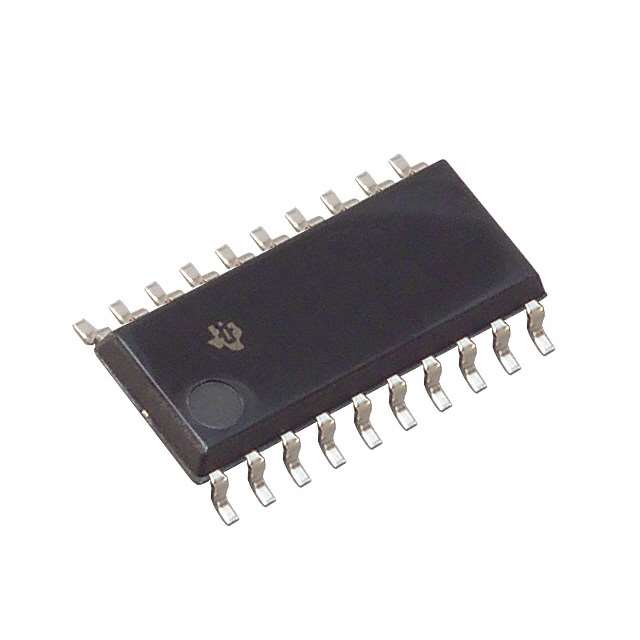SN74LV245ATNSE4
Product Overview
Category
SN74LV245ATNSE4 belongs to the category of integrated circuits (ICs).
Use
It is commonly used as a bidirectional octal bus transceiver.
Characteristics
- Voltage Level: 3.3V
- Logic Family: LV
- Number of Channels: 8
- Package Type: TSSOP
- Operating Temperature Range: -40°C to +85°C
Package and Quantity
The SN74LV245ATNSE4 is available in a TSSOP package. It is typically sold in reels or tubes, with a quantity of 2500 units per reel/tube.
Specifications
- Supply Voltage Range: 2V to 5.5V
- High-Level Input Voltage: 2V to VCC
- Low-Level Input Voltage: GND to 0.8V
- High-Level Output Voltage: VCC - 0.6V
- Low-Level Output Voltage: 0.4V
- Maximum Input Current: ±10mA
- Maximum Output Current: ±32mA
- Propagation Delay Time: 7ns (max)
- Rise/Fall Time: 2.5ns (typ)
Pin Configuration
The SN74LV245ATNSE4 has a total of 20 pins. The pin configuration is as follows:
- DIR (Direction Control)
- OE (Output Enable)
- A1 (Input/Output)
- B1 (Input/Output)
- A2 (Input/Output)
- B2 (Input/Output)
- A3 (Input/Output)
- B3 (Input/Output)
- A4 (Input/Output)
- B4 (Input/Output)
- GND (Ground)
- B5 (Input/Output)
- A5 (Input/Output)
- B6 (Input/Output)
- A6 (Input/Output)
- B7 (Input/Output)
- A7 (Input/Output)
- B8 (Input/Output)
- A8 (Input/Output)
- VCC (Supply Voltage)
Functional Features
- Bidirectional Data Transfer: The SN74LV245ATNSE4 allows data to be transferred bidirectionally between two buses.
- Direction Control: The DIR pin controls the direction of data flow.
- Output Enable: The OE pin enables or disables the outputs.
Advantages and Disadvantages
Advantages
- Wide Operating Voltage Range: The SN74LV245ATNSE4 can operate within a voltage range of 2V to 5.5V, making it compatible with various systems.
- High-Speed Operation: With a propagation delay time of only 7ns, this IC ensures fast data transfer.
- Compact Package: The TSSOP package offers a small footprint, making it suitable for space-constrained applications.
Disadvantages
- Limited Channel Count: The SN74LV245ATNSE4 has 8 channels, which may not be sufficient for applications requiring a higher number of data lines.
Working Principles
The SN74LV245ATNSE4 operates as a bidirectional bus transceiver. It allows data to be transferred bidirectionally between two buses by controlling the direction of data flow using the DIR pin. The OE pin enables or disables the outputs, providing flexibility in controlling the data transfer.
Detailed Application Field Plans
The SN74LV245ATNSE4 is commonly used in various applications, including:
- Microcontroller Interfacing: It facilitates communication between microcontrollers and external devices, such as sensors, displays, and memory modules.
- Data Communication Systems: It is used in data communication systems to enable bidirectional data transfer between different subsystems.
- Industrial Automation: The IC finds applications in industrial automation systems for interfacing various control modules and sensors.
Detailed Alternative Models
- SN74LV245A: This is a similar octal bus transceiver from Texas Instruments, offering the same functionality but with different package options.
- 74HC245: This is a popular alternative from NXP Semiconductors, providing similar bidirectional bus transceiver capabilities.
These alternative models can be considered based on specific requirements and availability.
Word count: 507 words
Lista 10 Vanliga frågor och svar relaterade till tillämpningen av SN74LV245ATNSE4 i tekniska lösningar
Sure! Here are 10 common questions and answers related to the application of SN74LV245ATNSE4 in technical solutions:
1. What is SN74LV245ATNSE4? SN74LV245ATNSE4 is a non-inverting octal bus transceiver with 3-state outputs. It is commonly used for level shifting and signal buffering in digital systems.
2. What is the voltage range supported by SN74LV245ATNSE4? SN74LV245ATNSE4 supports a voltage range of 1.65V to 5.5V, making it compatible with a wide range of digital systems.
3. How many channels does SN74LV245ATNSE4 have? SN74LV245ATNSE4 has 8 bidirectional channels, allowing for simultaneous data transmission in both directions.
4. What is the maximum data transfer rate supported by SN74LV245ATNSE4? SN74LV245ATNSE4 can support data transfer rates up to 100 Mbps, making it suitable for high-speed applications.
5. Can SN74LV245ATNSE4 be used for level shifting between different voltage domains? Yes, SN74LV245ATNSE4 can be used for level shifting between different voltage domains, as long as the voltage levels are within its supported range.
6. Does SN74LV245ATNSE4 have built-in protection features? Yes, SN74LV245ATNSE4 has built-in ESD protection on all inputs and outputs, providing robustness against electrostatic discharge events.
7. Can SN74LV245ATNSE4 be used in bi-directional communication systems? Yes, SN74LV245ATNSE4 is designed for bidirectional data transmission, making it suitable for use in bi-directional communication systems.
8. What is the power supply voltage required for SN74LV245ATNSE4? SN74LV245ATNSE4 requires a power supply voltage of 1.65V to 5.5V, which can be provided by a typical digital system power source.
9. Can SN74LV245ATNSE4 handle high current levels? SN74LV245ATNSE4 has a maximum output current of ±12mA, allowing it to drive relatively high loads without external buffering.
10. Is SN74LV245ATNSE4 available in different package options? Yes, SN74LV245ATNSE4 is available in various package options, such as TSSOP and SOIC, providing flexibility for different PCB layouts and assembly processes.
Please note that these answers are general and may vary depending on the specific application and requirements. It is always recommended to refer to the datasheet and consult with technical experts for accurate information.


